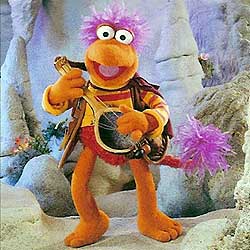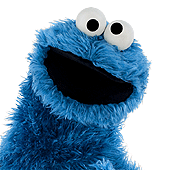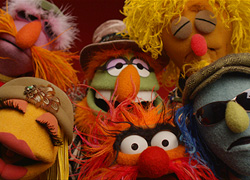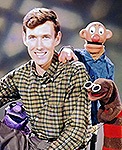theprawncracker
Well-Known Member
- Joined
- Dec 14, 2004
- Messages
- 13,202
- Reaction score
- 534
Hey gang! This is a paper I wrote for English at the end of this school year. It's not the whole thing, I'll post pieces of it at a time. But here's the first part of the paper... Enjoy! 
Still rubbing the sleep from his eyes, a young boy with mussed up brown hair and Bugs Bunny pajamas moves into his family room. The boy thoughtlessly flips on the television set and hears a familiar and welcoming tune emitting from it. He soon spies a dark green lamppost identifying the name of a street he’s never been to but has known all his life. Suddenly, the boy is told to “Get lost!” by a fuzzy green creature that pops out of a nearby garbage can. The camera then pans down the rest of the street, passing a stoop where children are playing with furry monsters, a courtyard where an eight foot tall yellow bird waves and greets you with a chipper welcome, a small store where a blue, googly-eyed monster devours a plate of numerous cookies in seconds.
In 1969 a television show was developed from the creative minds of Jim Henson and Joan Ganz Cooney that would change the medium of children’s entertainment forever. This show was Sesame Street. “You’ve never seen a street like Sesame Street. Everything happens here. You’re gonna love it!” (Sesame Street: Old School, Volume 1) declares human cast member Gordon (played by Matt Robinson in the first season) as the first lines of the first episode, setting the tone for the entirety of the show. For thirty-nine broadcast seasons the Muppets and cast members of the famous address of 123 Sesame Street have changed the face of children’s television for the better. The show was originally designed as a way for inner-city kids to see that their surroundings don’t have to be as bleak as they appear. By setting the show in a more urban street and casting the two main adult human characters, Susan and Gordon, as a young black couple (very rare for 1969), it would be easier for inner-city kids to connect with the show. Soon, however kids from all walks of life began to find a home on Sesame Street, learning the alphabet, counting, spelling, and basic math skills like addition and subtraction. Gerry Lesser, the original director of curriculum for Sesame Street remembers that, “In 1968 we didn’t know what we were getting into…we didn’t know that television could teach…It hadn’t been done before” (Borgenicht, 13). Sesame Street quickly became a roaring success, but there was still something missing. In the first pilot episodes of the show, the segments featuring Jim Henson’s Muppet characters were taped inserts shown between “street” segments, animations, and films. During the test shows the segments featuring the Muppets held the kid’s attention for much longer than the segments starring only the human characters engaging in educational conversations. It was instantly decided by the producers that they’d mix the worlds of reality and fantasy. Joan Ganz Cooney, co-creator, said, “We didn’t plan to have Muppets on the street interacting with the human cast members because we thought that would confuse the children. But we decided that was nonsense” (Borgenicht, 15). Thus, street-dwelling, interacting characters such as Big Bird and Oscar the Grouch were born.
This combination of fantasy and reality worlds led to segments where the Muppet characters interacted with children, having real, entirely unscripted conversations with them. Jane Henson, wife of Jim Henson tells a story about a little boy who came to the set of Sesame to tape a segment with Kermit the Frog (performed by Jim Henson). In between the takes of the segment, the little boy stood with Jane Henson and watched as Jim rehearsed with Kermit on his hand. Jane asked the boy if he knew who the man was. “’Yep,’ said the little boy confidently. ‘He’s the man who holds up Kermit while he’s working’” (Borgenicht, 82). It’s because children find the characters to be so real that they can connect so deeply with them. Kids find it easy to connect with characters like Grover, Elmo, Cookie Monster, Ernie, Bert, and countless other Muppets. Veteran puppeteer Kevin Clash, performer of the immensely popular character Elmo, relates his experience relating with kids seeing him on the set with a character, “Kids don’t look at us, they don’t know us… [The Muppet] is their friend, they don’t know me! They just know me as someone holding their friend” (“A&E Biography”). Characters like Elmo were created as double-edged swords, so to speak. On one end, they’re some of the most entertaining and endearing characters in the industry, and on the other, their personalities fill the needs of the curriculum pin-pointed by child development and learning researchers. “Big Bird…questioned the same things that children at home might question. Ernie…would teach basic reasoning or logic…Bert was the more serious partner who would keep Ernie and check, and act as the good-natured fall guy. And Oscar the Grouch was intended to help kids learn about their positive and negative emotions, and to learn that feelings like anger and grouchiness were natural” (Borgenicht, 16). These personality types possessed by the Muppets of Sesame Street represent the building blocks of a child’s psyche. Children are curious like Big Bird, fun-loving like Ernie, serious like Bert, and grumpy like Oscar. They aren’t merely one single emotion or thought process; they are a unique puzzle with the pieces put together perfectly. Because of this, a show like Sesame Street, which is used for the purpose of educating children, must have characters that display all of the various pieces of the puzzle that is the mindset of a child.

Sesame Seeds: The Children of Sesame Street
Still rubbing the sleep from his eyes, a young boy with mussed up brown hair and Bugs Bunny pajamas moves into his family room. The boy thoughtlessly flips on the television set and hears a familiar and welcoming tune emitting from it. He soon spies a dark green lamppost identifying the name of a street he’s never been to but has known all his life. Suddenly, the boy is told to “Get lost!” by a fuzzy green creature that pops out of a nearby garbage can. The camera then pans down the rest of the street, passing a stoop where children are playing with furry monsters, a courtyard where an eight foot tall yellow bird waves and greets you with a chipper welcome, a small store where a blue, googly-eyed monster devours a plate of numerous cookies in seconds.
In 1969 a television show was developed from the creative minds of Jim Henson and Joan Ganz Cooney that would change the medium of children’s entertainment forever. This show was Sesame Street. “You’ve never seen a street like Sesame Street. Everything happens here. You’re gonna love it!” (Sesame Street: Old School, Volume 1) declares human cast member Gordon (played by Matt Robinson in the first season) as the first lines of the first episode, setting the tone for the entirety of the show. For thirty-nine broadcast seasons the Muppets and cast members of the famous address of 123 Sesame Street have changed the face of children’s television for the better. The show was originally designed as a way for inner-city kids to see that their surroundings don’t have to be as bleak as they appear. By setting the show in a more urban street and casting the two main adult human characters, Susan and Gordon, as a young black couple (very rare for 1969), it would be easier for inner-city kids to connect with the show. Soon, however kids from all walks of life began to find a home on Sesame Street, learning the alphabet, counting, spelling, and basic math skills like addition and subtraction. Gerry Lesser, the original director of curriculum for Sesame Street remembers that, “In 1968 we didn’t know what we were getting into…we didn’t know that television could teach…It hadn’t been done before” (Borgenicht, 13). Sesame Street quickly became a roaring success, but there was still something missing. In the first pilot episodes of the show, the segments featuring Jim Henson’s Muppet characters were taped inserts shown between “street” segments, animations, and films. During the test shows the segments featuring the Muppets held the kid’s attention for much longer than the segments starring only the human characters engaging in educational conversations. It was instantly decided by the producers that they’d mix the worlds of reality and fantasy. Joan Ganz Cooney, co-creator, said, “We didn’t plan to have Muppets on the street interacting with the human cast members because we thought that would confuse the children. But we decided that was nonsense” (Borgenicht, 15). Thus, street-dwelling, interacting characters such as Big Bird and Oscar the Grouch were born.
This combination of fantasy and reality worlds led to segments where the Muppet characters interacted with children, having real, entirely unscripted conversations with them. Jane Henson, wife of Jim Henson tells a story about a little boy who came to the set of Sesame to tape a segment with Kermit the Frog (performed by Jim Henson). In between the takes of the segment, the little boy stood with Jane Henson and watched as Jim rehearsed with Kermit on his hand. Jane asked the boy if he knew who the man was. “’Yep,’ said the little boy confidently. ‘He’s the man who holds up Kermit while he’s working’” (Borgenicht, 82). It’s because children find the characters to be so real that they can connect so deeply with them. Kids find it easy to connect with characters like Grover, Elmo, Cookie Monster, Ernie, Bert, and countless other Muppets. Veteran puppeteer Kevin Clash, performer of the immensely popular character Elmo, relates his experience relating with kids seeing him on the set with a character, “Kids don’t look at us, they don’t know us… [The Muppet] is their friend, they don’t know me! They just know me as someone holding their friend” (“A&E Biography”). Characters like Elmo were created as double-edged swords, so to speak. On one end, they’re some of the most entertaining and endearing characters in the industry, and on the other, their personalities fill the needs of the curriculum pin-pointed by child development and learning researchers. “Big Bird…questioned the same things that children at home might question. Ernie…would teach basic reasoning or logic…Bert was the more serious partner who would keep Ernie and check, and act as the good-natured fall guy. And Oscar the Grouch was intended to help kids learn about their positive and negative emotions, and to learn that feelings like anger and grouchiness were natural” (Borgenicht, 16). These personality types possessed by the Muppets of Sesame Street represent the building blocks of a child’s psyche. Children are curious like Big Bird, fun-loving like Ernie, serious like Bert, and grumpy like Oscar. They aren’t merely one single emotion or thought process; they are a unique puzzle with the pieces put together perfectly. Because of this, a show like Sesame Street, which is used for the purpose of educating children, must have characters that display all of the various pieces of the puzzle that is the mindset of a child.

 Welcome to the Muppet Central Forum!
Welcome to the Muppet Central Forum! Back to the Rock Season 2
Back to the Rock Season 2 Sesame Street Season 54
Sesame Street Season 54 The Muppets Mayhem premieres
The Muppets Mayhem premieres Bear arrives on Disney+
Bear arrives on Disney+ Sam and Friends Book
Sam and Friends Book Oh, and ISNorden, I DID get an A on this paper.
Oh, and ISNorden, I DID get an A on this paper. 
